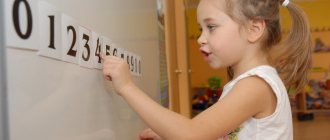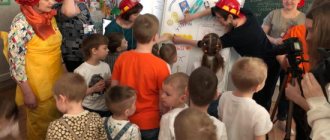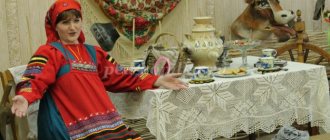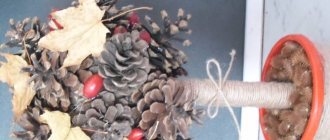Synopsis of GCD for FEMP in kindergarten “Counting within five.” Middle group
Abstract of the GCD in mathematics “Counting to five” in the middle group
Age group: middle group (4-5 years). Topic: Counting to 5. Goal: Consolidating counting to 5. Integration of educational areas : Cognitive, communicative.
Program tasks:
Cognitive: Practice counting up to 5. Train the ability to compare objects by size. Reinforce knowledge of colors (red, yellow, green). Developmental:
Develop coherent speech, memory, attention, logical thinking.
Educational
: To foster activity, independence, and the ability to work in a team.
Objectives : Practice direct counting up to 5. Train the ability to compare objects by size. Strengthen knowledge of colors. Develop coherent speech, memory, attention, logical thinking. Foster activity, independence, and the ability to work in a team. Forms of work: Speech situation, problem solving, reading, joint actions, game exercises. Technologies: problem-based learning, health-saving. Preliminary work : Introducing children to a geometric figure (circle, the size of objects, colors (red, yellow, green, blue) and associate with nature, counting within 5. Materials and equipment: Egg, dinosaur. Pictures: cloud, sun, flower, grass. Red, yellow, green pencils and sheets with drawn beads. Pictures with numbers, flowers with detachable petals.
GCD progress:
Motivational stage: - Hello guys. Today I came into the group and saw an egg. Whose it is and where I don’t understand from where. - Oh, guys - this is the same. (Wow, this is a dinosaur) Let's come up with a name for him. (Rex, Molly, Dino, etc.) - What a great fellow you are. The dinosaur whispers in the teacher's ear. Approximate stage: - Rex says that if he puts the numbers up to five in order, then he can return to his mother. - Rexik is very small, and you are already very big and know how to count. True (Yes, we can.) - Let's teach Rex to count from 1 to 5 and help him arrange them in order (Yes, let's do it.) - Well done... Commendable. Guys, we will evaluate some tasks with a gesture. If you liked the task, then clenched your fist and thumbs up. If you don’t like the task, then clenched your fist and thumbs down. (Showing gestures). Is everyone clear? Ready (Yes. Ready.) Performing stage: Now listen to the story: The pencils in the box got into trouble. Blue said: “I am the most important, the children love me the most.” They paint with my color, what? (Sky, cloud) “No, I’m the most important,” said the red pencil. They paint with my color (Flower) - No, I’m the most important, said the green pencil. They paint with my color (Christmas tree, grass) “Argue, argue,” the yellow pencil thought to himself, I already know that I am the most important one. And children love me the most because they paint with my color. (Sun) - Attention question: How many pencils were in the box? Which ones (Three, four. Red, green, yellow, blue.) - Thank you, young people. - Pencils will help you guys cope with the next task, but first we’ll do gymnastics for the fingers. - Now, please get your hands ready and count with me: (showing two palms) In our group, girls (shake your right hand) and boys (shake your right hand, we’ll make friends with little fingers: 1, 2, 3, 4, 5! (Fold the fingers of your right hand one by one) Let’s start counting again: 1, 2, 3, 4, 5 (Fold the fingers of the left hand one by one) – Now we’ve finished counting! So, look at what you have drawn on the pieces of paper (circles) Let’s we will call them beads (Let's) - Guys, what shape are the beads (Round) - They are the same size (no) - Let's decorate the beads. - You will decorate the large bead with a red pencil, show with your finger (I check). - The small yellow bead, show with your finger (checking). - The middle bead is green, point with your finger (checking). - Guys, you all worked very hard. I’m very pleased. How would you rate your work? - Let’s take a rest, guys. Let’s warm up? - Everyone get up and stand in a circle on the carpet. - Repeat the movements after me. (All movements according to the text) 1, 2, 3, 4.5 (All children show their palms. They repeat the movements.) We all know how to count, We also know how to rest - Let's put our hands behind our backs, Raise our heads higher And breathe easily, easily. 1, 2, 3, 4, 5! Let's stomp our feet! 1, 2, 3, 45! Let's clap our hands! We will pull ourselves up now On our toes as many times Exactly as many times as we have fingers on one hand. - Wonderful. — Did you like the physical education session? We rested a bit. Let's continue. — Guys, please help me collect a flower for our dinosaur. All the petals scattered. - What shape is the middle of the flower (Circles) Collect the petals around the circle. - Happened. Great. — How many petals does a flower have? - What colour? - Well done. How would you rate it? - Now I want to ask you to help the dinosaur put the numbers in order. Can you help? (Yes) - There are numbers on the table in front of you, put them in order together. - Well done. So, let's evaluate the task. Reflective stage: - You all tried very hard, but what do you think, our little dinosaur has learned to count (Yes.) - Let's count together from 1 to 5 again. (Count in unison.) - Thank you guys! Now I can return to my mother. Goodbye. (Please. Bye. Come to us again.) - Guys, what did you like most today? (I select several guys) - What did you find difficult in the lesson? — Thank you guys for your wonderful answers. Prospective stage: - Guys, ask your parents this evening how they learned to count. And tomorrow we will discuss this with you.
We recommend watching:
Summary of a lesson in mathematics in the middle group “Entertaining mathematics” Plan of an open lesson on FEMP in a correctional group of different ages at a preschool educational institution Summary of the final lesson in mathematics in the middle group Synopsis of direct organized activities in mathematics. Middle group
Similar articles:
Math lesson “Rectangle” in the middle group of kindergarten
Mathematics lesson “Ordinal counting” in the middle group
Summary of mathematics lesson in the middle group “Number and figure 5”
Order No. 981662
Goal: forming the number “5” and designating it as the number “5”. Develop memory, imagination, thinking.
Tasks:
1. Introduce the number and number 5, teach how to correlate the number of objects with the number. Develop mathematical speech, mental counting skills within 1 to 5, and the ability to work independently.
Equipment: board, colored chips.
Handouts: strips, chips for each child, cards with the number “5” for each child.
Demonstration material: pictures of trees, drawn and real coins of “1 kopeck”, “1 ruble”, “5 kopecks”, “5 rubles”. Card with the number "5".
Educational work: Hello guys, let's say hello to everyone.
Guys, please look at your fingers. How many are there? (Fingers) How many fingers do you have? (5) Can you count in such a way that it would be clear how 5 came about? (One finger - little finger (bends), etc.)
Children repeat your actions.
V-l: Can you say there are five little fingers in total on your hand? Why? (And five of what? (Five fingers). You know how to count fingers. Now the workers need to be given a job: clap your palms 5 times, and after each clap I will throw pebbles. How many pebbles will be in the jar? Let’s check. Get ready, let’s start!
You don't show anything, you just throw pebbles into the jar.
V-l: Take your time so that I have time to throw a pebble, and count. Let's check. How many times did you clap? (Five).
You place the chips in a row and count for yourself.
V-l: One, two... five, only five times they clapped, as many as they planned, as many as they did.
One two three four five!
Let's count fingers
Strong, friendly, all so necessary.
On the other hand there are five:
One two three four five.
Progress of the lesson.
Vl: Now let’s play math games. Look how many chips are on the board? Now jump and count as many times as there are chips.
What a great fellow you are, how many fingers are on your hand - you counted, how many times you clapped - you counted, how many times you jumped - you counted! Well done! But counting the pictures... it’s unknown whether it will work or not! Sit down.
Children take chairs and sit at tables.
V-l: Well, don’t you count this? (Let's count... five. Five trees). Five trees? Let's check. One tree - birch (dot, and one more tree - oak (dot), and one more tree - pine, and one more tree - spruce (dot, and one more tree - rowan (dot). One (counting dots, two ... five. Total (general hand gesture) five trees. Counted correctly, 5 trees in total.
Q: Prove that there are 5 trees. When you put mugs instead of a tree, say out loud which tree you are putting in place. What is our first tree? (Birch) So what do you say? (One tree - birch). How many circles did you put in? (One)
Point to the next tree, etc.
V-l: How many chips did you put in? (5). So how many trees do we have in total? (5 trees). Let's count together.
The trees were counted, well done!
Repeat the method.
Vs: (Intonation changes) Oh, the bunny has come!
Bunny: What are you talking about here?
Vs: Bunny, we are talking about how 5 trees are formed
Vs: Who will explain to Bunny when they say “5 what”? Yes, when one, and another, and another, and another, and another (point to each dot) are somehow similar. Then they can be designated by dots.
Bunny: I understand that. What am I going to carry with me? But you’ll spill it and count incorrectly!
Vs: (Excitingly). Do you know, Bunny, what the adults came up with (a miracle... They came up with the idea of denoting the number five with the number five. You put the number five “5” (put it) and you won’t lose it.
Remove the chips and put numbers next to the pictures.
Vs: Without counting, when you see this number, you can say: what does this number five mean? (Total 5) Five of what? (Five units). It could be 5 books, 5 plates, five pencils, 5 kopecks (shows 5 coins... And you know what else the adults came up with! Hide all 5 kopecks in one coin. How did they do it? They wrote the number 5.
Show a large drawn coin 5 and a real one.
V-l: Then look at your parents’ coins, how people conveniently came up with storing coins.
Place coins of “1 kopeck” or “5 rubles” and “1 rubles” next to the “5 kopeck” coin.
Round dance game
A bunny in its paws is a card with the number “5”, the number is upside down.
Bunny: While you were playing, I forgot what it was? (Number 5). I asked A.S. what kind of picture this was. She said: “This is not a picture, this will tell you how much to take.” I put her like this, she is silent. I turned her over like that - she’s still silent, doesn’t speak.
V-l: Does it say anything to you? (this is the number five, it says that you need to take something like 5).
Bunny: Why five, don’t you understand? (Five units)
Vs: That's right, 5 units of what you need.
Bunny: Well, now I understand everything. And you guys are so good, you were able to explain everything to me.
Analysis:
V-l: Guys, what did we teach today? (Answers) What sets did we work with? What number did you meet?
And now it's time to go for a walk.
Lesson summary “Counting to 5”
Summary of a lesson on mathematical development in the middle group (4-5 years old)
Topic: Counting to 5.
Goal: Strengthen counting to 5. Continue to form mathematical concepts in children.
Tasks:
Practice counting to 5.
Foster activity, independence, and the ability to work in a team.
Development of cognitive processes.
3. Thematic
4. Traditional
5. 20 min.
6. Teacher, group of children
7. 4-5 years
8. Equipment: pictures with numbers, pictures with the number of items, flowers rose, chamomile, lily, bell, dandelion, a flower for each child.
9. Reading the poem “Merry Counting”
10. Demonstration, reading a poem, visualization, surprise moment, physical. just a minute.
11. Progress of the lesson.
Introduction:
"Merry Count"
Samuel Marshak
Here is one (or unit), very thin, like a knitting needle,
But this is number two. Admire how it looks: The deuce arches its neck, Its tail drags behind it.
And behind the two - look - the number three appears. Three - the third of the icons - Consists of two hooks.
After three come four, A sharp protruding elbow.
And then she went to dance. The number five on the paper. She extended her hand to the right and bent her leg sharply.
-Hello children. Today I came to you with a very interesting poem. I heard that you are already quite big and can count... Is that true? Well, who can count to 5?
Well done... Commendable and here is my poem... Reading...
Main part.
- Now I want to ask you to help me, while I was walking to you there was a real mess in my bag, so I have numbers, but I need to sort out the pictures. But alas, I don’t know how to do it myself... Can you help me? Lay out.
- Well done. I couldn't have done it without you.
Physical minute.
— We rode on the swings.
We went around all the carousels.
One, two! One, two!
I felt dizzy.
- I have one more task for you; you need to carefully monitor what I do and remember. One day the sun woke up very early, and looking at the clearing, she saw that all the flowers had lowered their heads and were depressed. And the sun decided to warm them up. The sun thought that this should make them warmer. The sun spread its rays across the clearing and then the first flower opened.. (red rose) What is it called? What colour is he? The second flower (blue bell) opened next. Then the third (white chamomile). Then the fourth (dandelion yellow). And finally, the fifth is a delicate pink lily. When the sun saw how happy the flowers were, it promised to wake them up every morning. Since then, it has become a tradition that every morning there will be sunshine and flowers in the meadows.
“And now I ask you to answer a few questions.”
-How many flowers were there in the clearing?
-What color was the 1,2,3,4,5 flower?
-What was the name of the 1,2,3,4,5 flower?
- Well done. You all tried very hard, so I want to give you a gift of just such a small flower.
Conclusion.
- Let's count to 5.
— What did you like most today?
-And here’s your homework - ask your parents how they learned to count. And in the next lesson we will discuss it with you.
12.Literature:
1. Poem “Merry Count” https://detskiychas.ru/stihi/malysham/stihi_pro_tsifry/
2. Shcherbakova E.I. Methods of teaching mathematics in kindergarten: Textbook. aid for students doshk. department and faculty avg. ped. textbook establishments. - M: Publishing House, 1998. -272 p.





